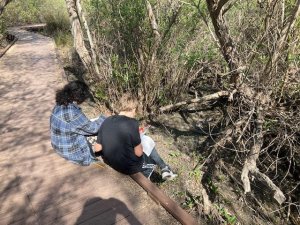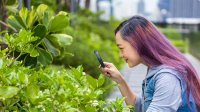Outdoor Science Lessons Foster Environmental Stewardship
By creating opportunities for students to study outside, teachers can connect their classes to nature through hands-on lessons.
Your content has been saved!
Go to My Saved Content.“When’s the next time your class is going outside? Can I come?!” As a teacher, it’s great to get feedback from colleagues, but your efforts are really validated when students are talking positively about your class. I have been a middle school science teacher in Southern California for 30 years now, and I’ve found that engaging students in activities outdoors provides a spark that allows them to think about the environment and their place in it.
Students need to get outdoors to connect positively with each other and to our communities. Emotionally and behaviorally, our students benefit from natural places. How can we give them ways to interact in those natural spaces so that they will grow intellectually and be interested and motivated to be better environmental stewards? In order to create great learning experiences in a small preserve a mile away from my school, I had to consider the logistics of getting the students over there and which activities would best connect them to nature.
School Buy-In Is Key
First, you have to take some steps to get the kids out the door. Early on, meet with colleagues to pitch the idea of taking students off campus and to ask how to do it. During these collegial conversations, amazing ideas always come out. In the end, I was sold on taking the students for three periods at a time (about 2 hours and 15 minutes). In your case, you may need longer or shorter, depending on proximity to an open space. Remember, colleague buy-in is key, since the students may need to miss some of their other classes.
Next, choose an outdoor space that will work for you, figure out which activities to do with students, and calculate the travel and instructional time needed. If you have your kids for longer periods of time (elementary) or need to bus to a location farther away (which is likely for urban schools), then early meetings like these are vital. These conversations, especially with your principal, lay the foundation for approval from your school district and could have the added benefit of helping you find funds for travel. Seek out money sources if needed, get approvals, and begin collecting student permission slips. As you read on, remember that activities can be creatively adapted to any potential young steward!
Activities to Enhance Outdoor Experience
Each time you go out with students, focus on one or two activities. These help students connect with nature, especially those who don’t get to experience it regularly. Here are some ideas I’ve used from different trips.
Use the Seek by iNaturalist app. Seek identifies plant and animal species based on photos that the user takes. Seek was an easy install for my students on their smartphones. Before going on any excursion, encourage the students to make the download. In addition to its coming in handy as they try to identify plants and animals in the field, students can use it as they journal in their science notebooks or gather research for the Canva presentations. Students can pair up if they don’t have a phone, and I was pleased with how easily they downloaded the app. Warning: Students may get competitive trying to identify species.
Use Google Earth Timelapse. This app is a great way to provide context to your outdoor excursion and to have your students see how an area has changed. Google recently added this feature by utilizing millions of satellite photos from the past four decades. Students can see back nearly 40 years now, and images will be added every year. This gives students context for their observations. It can help them to predict future impacts on an area due to human population growth.
I take my students to the Lake Calavera Preserve. Google Earth Timelapse of the area shows the loss of wildlife corridors and open space due to urban sprawl. Students from urban areas can view how the population growth of the city affects formerly open adjacent spaces.
Test water samples. Monitoring creek and lake samples can shed light on the health of the ecosystem. Students collect samples, then can use kits to check nutrient levels when we return to the classroom. Our area is impacted by the surrounding neighborhoods and their water runoff, so we test nitrogen and phosphorus levels using Hach test kits. We haven’t had much rain this year, and so our samples showed normal levels of these nutrients. Depending on the timing of your trips, be prepared to have students record some interesting measurements.
Write and draw about it. During your adventures, I recommend that you have students bring their science notebooks or journals. For our last visit to the preserve this year, I used Sarah Keel’s “sit spot” idea (from the linked article) and prompted my students to focus on observations and drawings of either a small or a big area. The important thing was to have them focus on the creatures present and how they interacted with each other. Recording observations in real time, and making reflections later, can really help kids to connect with the place they are in.

Have students display key learning. Prior to a trip, I let students know they will be using Canva to display information upon our return. For instance, we recently completed a “species of the month” project, so I had students document species that they found on our trip. Make a document with links to your student Canva presentations so that people can learn about what your students observed. Besides being able to get information about other species they saw, the students love to see each other’s work. Creating with Canva gives students a chance to go deeper, sharing something important about creatures nearby.
Did You Motivate Young Environmental Stewards?
Albert Einstein famously said, “Look deep into nature, and then you will understand everything better.” Students learn many things in our classrooms. However, getting them outside, whether in the schoolyard, to an open space nearby, or perhaps to one farther away, will give them a place for engagement and wonder. When students can connect, they will be motivated to use what they’ve learned about the environment to become the next generation’s environmental stewards, taking actions that make you and them proud.
